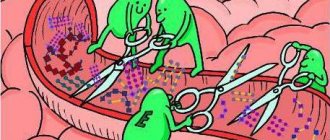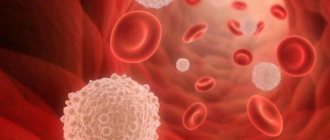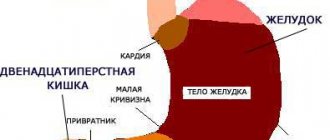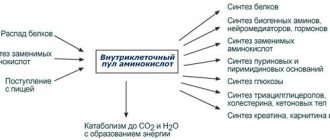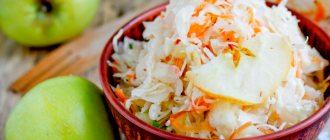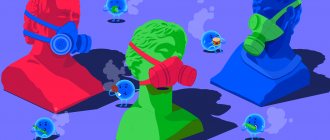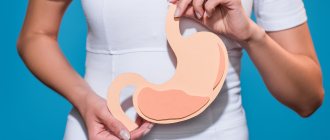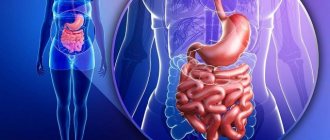Biochemistry of nutrition and digestion. Digestion and absorption of proteins, fats, carbohydrates.
10.3.1. The main site of lipid digestion is the upper small intestine. The following conditions are necessary for the digestion of lipids:- presence of lipolytic enzymes;
- conditions for lipid emulsification;
- optimal pH values of the environment (within 5.5 – 7.5).
10.3.2. Various enzymes are involved in the breakdown of lipids. Dietary fats in an adult are broken down mainly by pancreatic lipase; Lipase is also found in intestinal juice and saliva; in infants, lipase is active in the stomach. Lipases belong to the class of hydrolases; they hydrolyze ester bonds -O-CO- to form free fatty acids, diacylglycerols, monoacylglycerols, glycerol (Figure 10.3).
Figure 10.3. Scheme of fat hydrolysis.
Glycerophospholipids supplied with food are exposed to specific hydrolases - phospholipases, which cleave ester bonds between the components of phospholipids. The specificity of the action of phospholipases is shown in Figure 10.4.
Figure 10.4. Specificity of the action of enzymes that break down phospholipids.
The products of phospholipid hydrolysis are fatty acids, glycerol, inorganic phosphate, nitrogenous bases (choline, ethanolamine, serine).
Dietary cholesterol esters are hydrolyzed by pancreatic cholesterol esterase to form cholesterol and fatty acids.
10.3.3. Understand the structure of bile acids and their role in the digestion of fats. Bile acids are the end product of cholesterol metabolism and are formed in the liver. These include: cholic (3,7,12-trioxycholanic), chenodeoxycholic (3,7-dioxycholanic) and deoxycholic (3, 12-dioxycholanic) acids (Figure 10.5, a). The first two are primary bile acids (formed directly in hepatocytes), deoxycholic acid is secondary (as it is formed from primary bile acids under the influence of intestinal microflora).
In bile, these acids are present in conjugated form, i.e. in the form of compounds with glycine H2 N -CH2-COOH or taurine H2 N -CH2-CH2- SO3H (Figure 10.5, b).
Figure 10.5. The structure of unconjugated (a) and conjugated (b) bile acids.
15.1.4. Bile acids have amphiphilic properties: the hydroxyl groups and side chain are hydrophilic, the cyclic structure is hydrophobic. These properties determine the participation of bile acids in the digestion of lipids:
1) bile acids are capable of emulsifying fats; their molecules, with their non-polar part, are adsorbed on the surface of fat droplets, while at the same time hydrophilic groups interact with the surrounding aqueous environment. As a result, the surface tension at the interface between the lipid and aqueous phases decreases, as a result of which large fat droplets are broken into smaller ones;
2) bile acids, along with bile colipase, participate in the activation of pancreatic lipase , shifting its pH optimum to the acidic side;
3) bile acids form water-soluble complexes with hydrophobic products of fat digestion, which facilitates their absorption into the wall of the small intestine.
Bile acids, which penetrate into the enterocytes during absorption along with hydrolysis products, enter the liver through the portal system. These acids can be re-secreted with bile into the intestines and participate in the processes of digestion and absorption. Such enterohepatic circulation of bile acids can occur up to 10 or more times a day.
15.1.5. Features of absorption of fat hydrolysis products in the intestine are presented in Figure 10.6. During the digestion of food triacylglycerols, about 1/3 of them are completely broken down to glycerol and free fatty acids, approximately 2/3 are partially hydrolyzed to form mono- and diacylglycerols, and a small part is not broken down at all. Glycerol and free fatty acids with a chain length of up to 12 carbon atoms are soluble in water and penetrate into the enterocytes, and from there through the portal vein into the liver. Longer fatty acids and monoacylglycerols are absorbed with the participation of conjugated bile acids, which form micelles. Undigested fats can apparently be absorbed by the cells of the intestinal mucosa by pinocytosis. Water-insoluble cholesterol, like fatty acids, is absorbed in the intestine in the presence of bile acids.
Figure 10.6. Digestion and absorption of acylglycerols and fatty acids.
Transformations of amino acids under the influence of intestinal microflora
It is known that intestinal microorganisms also require the delivery of certain amino acids from food for their growth. The intestinal microflora has a set of enzyme systems that are different from the corresponding enzymes of animal tissues and catalyze a wide variety of transformations of food amino acids. Optimal conditions are created in the intestine for the formation of toxic breakdown products of amino acids: phenol, indole, cresol, skatole, hydrogen sulfide, methylmercaptan, as well as compounds that are non-toxic to the body: alcohols, amines, fatty acids, keto acids, hydroxy acids, etc.
All these transformations of amino acids caused by the activity of intestinal microorganisms are collectively called “rotting proteins in the intestines.” Thus, during the breakdown of sulfur-containing amino acids (cystine, cysteine, methionine), hydrogen sulfide H2S and methyl mercaptan CH3SH are formed in the intestine. Diamino acids - ornithine and lysine - undergo a decarboxylation process to form amines - putrescine and cadaverine.
From aromatic amino acids: phenylalanine, tyrosine and tryptophan, similar bacterial decarboxylation produces the corresponding amines: phenylethylamine, paraoxyphenylethylamine (or tyramine) and indolylethylamine (tryptamine). In addition, intestinal microbial enzymes cause gradual destruction of the side chains of cyclic amino acids, in particular tyrosine and tryptophan, with the formation of toxic metabolic products - cresol and phenol, skatole and indole, respectively.
After absorption, these products enter the liver through the portal vein, where they are neutralized by chemical binding with sulfuric or glucuronic acid to form non-toxic, so-called paired acids (for example, phenolsulfuric acid or sca-toxysulfuric acid). The latter are excreted in the urine.
The mechanism of neutralization of these products has been studied in detail. The liver contains specific enzymes - arylsulfotransferase and UDP-glucuronyltransferase, which catalyze, respectively, the transfer of a sulfuric acid residue from its bound form - 3′-phosphoadenosine-5′-phosphosulfate (FAPS) and a glucuronic acid residue also from its bound form - uridyl-diphosphoglucuronic acids (UDFHA) for any of these products.
Indole (like skatole) is preliminarily oxidized into indoxyl (respectively skatoxyl), which reacts directly in an enzymatic reaction with FAPS or UDPHA. Thus, indole binds in the form of ester sulfuric acid. The potassium salt of this acid is called animal indican, which is excreted in the urine (see Chapter 18). By the amount of indican in human urine, one can judge not only the rate of protein decay in the intestines, but also the functional state of the liver. The function of the liver and its role in neutralizing toxic products is often also judged by the rate of formation and excretion of hippuric acid in the urine after taking benzoic acid (see Chapter 16).
Thus, the human and animal body has a number of protective synthesis mechanisms, the biological role of which is to neutralize toxic substances that enter the body from the outside or are formed in the intestines from food products as a result of the vital activity of microorganisms.
Previous page | Next page
CONTENT
Gastrointestinal problems affect the entire body
Reduced protein digestion due to low proteolytic activity in the stomach (low acidity) or in the intestines (chronic pancreatitis), disruption of the integrity of the intestinal tract wall due to helminthiasis or incomplete neutralization of hydrochloric acid (hyperacid gastritis, impaired bile excretion) leads to consequences that affect activity the whole body.
Food allergies
In the early postnatal period (in newborns and up to 2-3 months), the permeability of the intestinal wall in children is even normally increased. This feature ensures the penetration of colostrum and mother's milk antibodies into the baby's blood and creates passive immunity for the baby. Colostrum also contains a trypsin inhibitor, which protects immunoglobulins from rapid hydrolysis.
However, in the presence of unfavorable circumstances (hypovitaminosis, individual characteristics, malnutrition), the permeability of the intestinal wall increases and an increased flow of cow's milk peptides into the baby's blood (with artificial feeding), peptides and substances present in mother's milk - food allergies develop. A similar situation can be observed in older children and adults with bile excretion disorders, helminthiases, dysbacteriosis, damage to the intestinal mucosa by toxins, etc.
Improving the health of the gastrointestinal tract and restoring the integrity of its wall, improving the biliary function of the liver significantly facilitates the treatment of allergies and atopies.
Some peptide regions of cow's milk albumin and human insulin are similar to each other. Therefore, when they cross the intestinal barrier, carriers of major histocompatibility complex D3/D4 antigens may experience cross-immune reactivity and, as a consequence, an autoimmune response against their own β-cells of the islets of Langerhans. It is believed that in the case of artificial feeding of infants, the risks increase and this can lead to insulin-dependent diabetes mellitus (type 1 diabetes mellitus).
Celiac disease
Celiac disease is an autosomal dominant progressive disease, with varying degrees of severity, with a frequency of up to 0.5-1%. Leads to changes in the jejunum: inflammation and smoothing of the mucous membrane, disappearance of villi and atrophy of the brush border, and the appearance of cuboidal enterocytes. The reason is congenital intolerance to the cereal gluten protein ( gluten ), or more precisely, its soluble fraction gliadin. The disease manifests itself after the introduction of gliadin-containing products (wheat, rye, barley), primarily semolina, into the infant’s diet.
The pathogenesis of the disease is still unclear; there is a hypothesis about a direct toxic effect on the intestinal wall and a hypothesis an immune response to a protein in the intestinal wall.
Catabolism of amino acids in the large intestine
In some situations, namely:
- when absorption of amino acids deteriorates,
- with an excess of protein foods,
- in case of disruption of the digestive glands,
- with decreased intestinal motility (constipation)
amino acids and undigested protein fragments reach the large intestine, where they are exposed to intestinal microflora. This process is called the rotting of proteins in the intestines. In this case, amino acid decomposition products are formed, which are
- toxins (ammonia, cadaverine, putrescine, cresol, phenol, skatole, indole, piperidine, pyrrolidine, hydrogen sulfide (H2S), methyl mercaptan (CH3SH) and others),
- neurotransmitters (serotonin, histamine, octopamine, tyramine, tryptamine).
Absorbed into the blood, these substances cause general intoxication, fluctuations in blood pressure, headaches, loss of appetite, decreased pain sensitivity, anemia, myocardial dystrophy, impaired gastric secretion; in severe cases, respiratory depression, cardiac activity and coma are possible.
Reactions of transformation of tyrosine and tryptophan
Reactions of rotation of lysine and arginine
Detoxification of rotting products
Neutralization of toxic substances coming from the large intestine occurs in the liver using two systems:
- microsomal oxidation system,
- conjugation system.
The purpose of the microsomal oxidation is
- in increasing the reactivity of the molecule and its ability to enter into a conjugation reaction,
- in imparting hydrophilicity to the molecule, which facilitates its excretion in the urine and the absence of accumulation in nervous and adipose tissue.
The purpose of the conjugation is
- in masking reactive and toxic groups (for example, in phenol this is the OH group).
0
Rotting of amino acids, neutralization of rotting products
ROTATION OF AMINO ACIDS
Amino acids that are not absorbed enter the large intestine, where they undergo decay. AMINO ACIDS DEPOSITION is the process of breakdown of amino acids under the action of enzymes produced by the microflora of the large intestine. Amino acids undergo the following transformations during decay:
DECARBOXYLATION REACTIONS:
Ornithine and lysine are affected. ORNITINE is not included in proteins, but is necessarily found in the body.
Decarboxylation products - PUTRESSINE and CADAVERINE - are toxic substances. They are part of cadaveric poisons.
Rice. Conversion of ornithine and lysine
RESTORATIVE DEAMINATION: (using the example of alanine)
DESULFURING
Sulfur-containing amino acids (methionine, cysteine) are desulfurized. As a result, hydrogen sulfide and methyl mercaptan are formed.
DECOMPOSITION OF CYCLIC AMINO ACIDS
The breakdown of tyrosine, phenylalanine, and tryptophan produces methane, carbon dioxide, ammonia, phenol, cresol, and indole.
All these substances are toxic. They enter the liver, where they are neutralized. The liver has two systems involved in the neutralization of these substances:
1. UDFGK - URIDINDIPHOSPHOGLUCURONIUM K-TA.
2. FAFS - PHOSFOADENOSINE PHOSPHOSULPHATE.
The process of neutralization is the process of conjugation of toxic substances with components of one of these systems, and the formation of conjugates that are already non-toxic substances.
Rice. Neutralization of phenol, cresol, indole
INDOXYL SULPHATE is neutralized and converted into sodium or potassium salt.
All these substances are excreted from the body in the urine.
Normally, the reaction to indole should be negative. If the reaction to indole is positive, the detoxifying function of the liver is impaired. A positive reaction to INDIKAN is observed with very active putrefaction of proteins in the large intestine.
| Previous section | Top level section | Next section |
ROTATION OF AMINO ACIDS
Amino acids that are not absorbed enter the large intestine, where they undergo decay. AMINO ACIDS DEPOSITION is the process of breakdown of amino acids under the action of enzymes produced by the microflora of the large intestine. Amino acids undergo the following transformations during decay:
DECARBOXYLATION REACTIONS:
Ornithine and lysine are affected. ORNITINE is not included in proteins, but is necessarily found in the body.
Decarboxylation products - PUTRESSINE and CADAVERINE - are toxic substances. They are part of cadaveric poisons.
Rice. Conversion of ornithine and lysine
RESTORATIVE DEAMINATION: (using the example of alanine)
DESULFURING
Sulfur-containing amino acids (methionine, cysteine) are desulfurized. As a result, hydrogen sulfide and methyl mercaptan are formed.
DECOMPOSITION OF CYCLIC AMINO ACIDS
The breakdown of tyrosine, phenylalanine, and tryptophan produces methane, carbon dioxide, ammonia, phenol, cresol, and indole.
All these substances are toxic. They enter the liver, where they are neutralized. The liver has two systems involved in the neutralization of these substances:
1. UDFGK - URIDINDIPHOSPHOGLUCURONIUM K-TA.
2. FAFS - PHOSFOADENOSINE PHOSPHOSULPHATE.
The process of neutralization is the process of conjugation of toxic substances with components of one of these systems, and the formation of conjugates that are already non-toxic substances.
Rice. Neutralization of phenol, cresol, indole
INDOXYL SULPHATE is neutralized and converted into sodium or potassium salt.
All these substances are excreted from the body in the urine.
Normally, the reaction to indole should be negative. If the reaction to indole is positive, the detoxifying function of the liver is impaired. A positive reaction to INDIKAN is observed with very active putrefaction of proteins in the large intestine.
| Previous section | Top level section | Next section |
